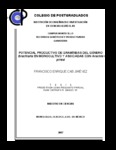| dc.description.abstract | El presente estudio se realizó de noviembre de 2005 a octubre de 2006, en Isla, Veracruz con clima cálido subhúmedo,. El objetivo fue determinar el rendimiento de forraje, tasa de crecimiento (TC), componentes morfológicos (CM, conformados por hoja, tallo y material muerto), composición botánica (CB), peso por tallo (PT), densidad y dinámica de aparición y muerte de tallos, de tres gramíneas en monocultivo y asociadas con la leguminosa Arachis pintoi. Se establecieron parcelas de 10 x 12 m de B. dictyoneura, B. brizantha cv. Toledo y el híbrido B. ruziziensis x B. brizantha cv. Mulato en monocultivo y asociados con A. pintoi y se pastorearon con ganado bovino cada 30 días. Los tratamientos se distribuyeron en un diseño de bloques completos al azar con cuatro repeticiones. Los resultados obtenidos evidencian que la época del año influyó en los rendimientos; la distribución estacional fue 21% (2600 kg MS ha-1) en nortes, 14% (1710 kg ) en seca y 65% (7850 kg) en las lluvias. En la época de nortes la mayor producción de forraje (p<0.05) fue en Toledo (3980 kg MS ha-1), en la seca Toledo+A. pintoi (2790 kg) y en lluvias en Toledo (11170 kg MS ha-1), mientras que en la acumulación total Toledo y B. dictyoneura fueron los mas productivos con 16800 y 15170 kg MS ha-1, respectivamente. Las mayores TC (p<0.05) se registraron en la época lluviosa con 56 kg MS ha-1 d-1 y las menores en la época de sequía, con 16 kg. Al final del experimento la CB fue de 62, 26 y 12% para gramínea, leguminosa y maleza, respectivamente, que se considera excelente en asociaciones. La CM fue de 65, 57 y 62% de hoja en nortes, seca y lluvias, respectivamente; durante los nortes y seca la mayor proporción de hojas (p<0.05) de gramíneas fue en B. dictyoneura con 74 y 66%, respectivamente, mientras que en las lluvias no hubo diferencias. No existió diferencia (P>0.05) en la densidad de tallos de las gramíneas en monocultivo y asociadas y el mayor valor ocurrió en febrero en B. dictyoneura (1902 tallos m-2) y el menor en abril en Toledo (446 tallos m-2). Las mayores y menores tasas de aparición de tallos ocurrieron en enero y abril con promedio de 16 y 3 tallos m-2 d-1. La mortalidad promedio más alta de tallos se registró en abril (15 tallos) y la menor en octubre (4 tallos). El mayor PT fue para Toledo (1513 mg tallo-1), seguidos por Mulato (941 mg) y B. dictyoneura (449 mg). Se concluye de este estudio que la mayor producción de forraje y tasa de crecimiento fue para las gramíneas en monocultivo; los mayores pesos por tallo fueron para Toledo y Mulato y la mejor asociación se logró con B. dictyoneura+ A. pintoi, por existir la mayor proporción de leguminosa._______The current study was done from November 2005 to October 2006 in Isla, Veracruz, which has warm, sub-humid weather. The objective was to determine the forage yield, growth rate (GR), morphological components (CM) (leaf, stalk, dead matter), botanical composition (CB), weight per stalk (WS), stalk density and apparition and death dynamics of three gramineae as single crops, and associated with the legume Arachis pintoi. Plots measuring 10 x 12 m were established with B. dictyoneura, B. brizantha cv. Toledo and the hybrid B. ruziziensis x B. brizantha cv. Mulato as single crops, and associated with A. pintoi. The treatments were distributed in full random blocks with four repetitions. The obtained results show that the time of year influences yield; seasonal distribution was 21% (2600 kg MS ha-1) in the norths season, 14% (1710 kg MS ha-1) in the dry season, and 65% (7850 kg MS ha-1) during the rainy season. During the norths season, the greatest forage production (P<0.05) was that of Toledo (3980 kg MS ha-1); in the dry season it was Toledo+A. pintoi (2790 kg MS ha-1); and in the rainy season, it was Toledo (11170 kg MS ha-1). As far as total accumulation, Toledo and B. dictyoneura were the most productive with 16800 and 15170 kg MS ha-1, respectively. The greatest GR (p<0.05) was registered in the rainy season at 56 kg MS ha-1 d-1, and the lowest in the dry season at 16 kg MS ha-1 d-1. At the end of the experiment, CB was 62, 26 and 12% for gramineae, legume, and weed, respectively, which is considered as excellent in associations. CM was 65, 57 and 62% leaf in the norths, dry, and rainy seasons, respectively. During the norths and dry seasons, the greatest leaf ratio (p<0.05) for gramineae was for B. dictyoneura with 74 and 66%, respectively, while there were no differences in the rainy season. There was no difference (P>0.05) in stalk density between gramineae as single crops and associated. The greatest value was in February for B. dictyoneura (1902 stalks m-2) and the lowest was in April for Toledo (446 stalks m-2). The highest and lowest stalk appearances occurred in January and April with an average 16 and 3 stalks m-2 d-1. The highest average stalk mortality was registered in April (15 stalks m-2 d-1), and the lowest was in October (4 stalks m-2 d-1). The highest PT was that of Toledo (1513 mg stalk-1), followed by Mulato (941 mg stalk-1) and B. dictyoneura (449 mg stalk-1). From this study, it can be concluded that the greatest forage production and growth rate was that of gramineae as single crops. The highest weights per stalk were those of Toledo and Mulato, and the best association was that of B. dictyoneura+ A. pintoi, since it had the highest legume ratio. | es |


